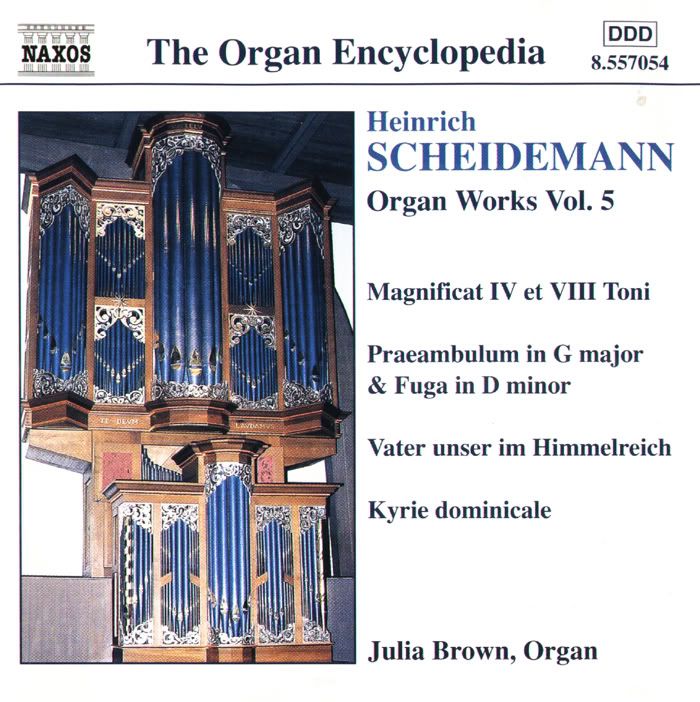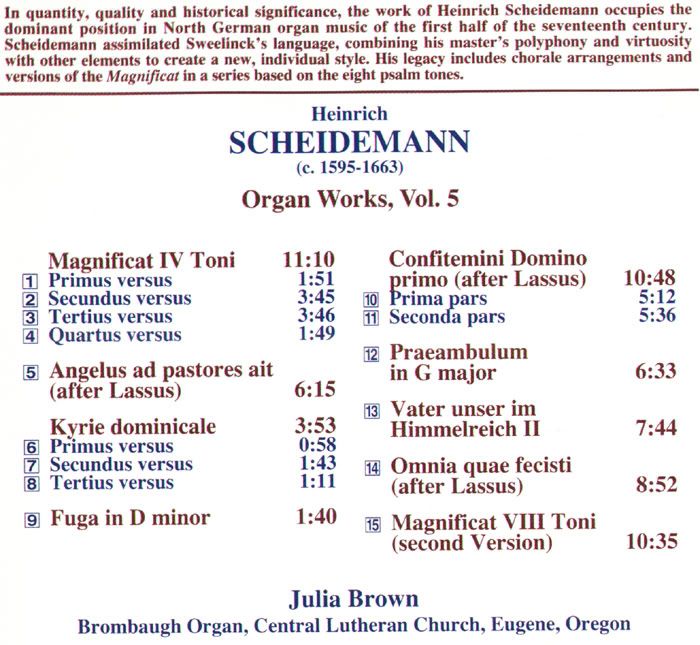 |
| NetLab · Rules · Torrent Tracker · Have a problem? · Eng/Rus |
 Help Help
 Search Search
 Members Members
 Gallery Gallery
 Calendar Calendar
|
| Welcome Guest ( Log In | Register | Validation ) | Resend Validation Email |
|
Posted: 05-05-2010, 22:24
(post 1, #961623)
|
||||||||||||||||||
|
Pro Member Group: Members Posts: 695 Warn:0% |
Heinrich Scheidemann (1595 - 1663) Organ Works, Vol.5 Label: Naxos, 8.557054 Year: 2004 Performer: Julia Brown - organ Tracklist: Magnificat IV Toni 01. Primus versus 02. Secundus versus 03. Tertius versus 04. Quartus versus 05. Angelus ad pastores ait (after Lassus) Kyrie dominicale 06. Primus versus 07. Secundus versus 08. Tertius versus 09. Fuga in D minor Confitemini Domino primo (after Lassus) 10. Prima pars 11. Secunda pars 12. Praeambulum in G major 13. Vater unser im Himmelreich II 14. Omnia quae fecisti (after Lassus) 15. Magnificat VIII Toni Total Playing Time: 01:07:30 Born in about 1595 in Wohrden in Holstein, where his father, a native of Hamburg, had recently been appointed organist, Heinrich Scheidemann studied between 1611 and 1614 with Sweelinck in Amsterdam. His father had moved from Wohrden by 1604 to take the position of organist at the Catharinenkirche in Hamburg, and the church supported his son’s study, In der Hoffnung, dass er ein braver Kunstler und dereinst ihr Org. werden sollte (in the hope that he might become a fine artist and some day their organist). When his studies in Amsterdam came to an end Sweelinck wrote a farewell canon for him, with the dedication Ter eeren des vromen Jongkmans Henderich Scheijtman, van Hamborgh, is dit geschreven bij mij, Jan P. Sweelinck, organist tot Amsterdam, op den 12den Novemb. 1614 (For the worthy young man Heinrich Scheidemann of Hamburg this is written by me, Jan P.Sweelinck, organist of Amsterdam, on 12th November 1614). In the late 1620s, and at least by 1629, he succeeded his father as organist at the Catharinenkirche, and in 1633 was appointed clerk of the church, marrying in the following year the daughter of a doctor. During his years at Hamburg Scheidemann established himself as an important figure in the world of North German organ music. His pupils included J.A.Reincken, later his assistant and successor, Werner Fabricius, who became organist at the Nikolaikirche in Leipzig, Wolfgang Wessnitzer of Celle, Jakob Lorentz of the Waisenhaus in Hamburg, and others of contemporary distinction. He served as a consultant on the construction of new instruments in Brunswick, Lubeck, Bremen and elsewhere, and saw to the enlargement of his own instrument at the Catharinenkirche by the organ-builder Gottfried Fritzsche, with the addition of a Brustwerk to make a four-manual instrument with the existing Hauptwerk, Ruckpositiv, and Oberwerk, pedals and 56 stops. He died during an epidemic of the plague in Hamburg in 1663, and his widow, in recognition of her husband’s services, received a pension from the city. Scheidemann’s important Magnificat settings were discovered in 1955 by Gustav Fock in a book of organ tablatures at Clausthal-Zellerfeld. The four organ verses were to be played at Vespers between the sung verses of the canticle, seemingly, in Hamburg tradition, replacing the third, fifth, seventh and ninth of these. Scheidemann’s cycle of Magnificat verses uses the eight psalm tones, two of which are here included. The Magnificat IV Toni suggests the psalm tone in the opening of the first versus, leaving the formal entry of the chant to the pedals. This is elaborated in the extended second versus, a chorale fantasia, with relatively ornate parts, and echo effects as it proceeds. The third versus, a chorale ricercare, is plainer in texture, and the setting ends with a fourth versus for the manuals only. Here the right hand introduces the psalm tone, adding, also with the left hand, a running counterpoint, in a three-part texture. The additional second version of the Magnificat VIII Toni here included, is, exceptionally, in one movement, its chant material developed throughout. Here again Scheidemann takes the opportunity of using echo effects by sudden alternation of manuals. There are twelve embellished versions of motets by other composers among Scheidemann’s organ compositions. The origin of one of these is uncertain, while one is by Hieronymus Praetorius, three by Hassler and seven by Orlando de Lassus. The first of the three here included of these last, Angelus ad pastores ait (The angel said to the shepherds), from the Sacrae cantiones of 1562, is a fine example of a form that was still an important element of the organ music of the time, a decorated version of a five-voice motet. Confitemini Domino (Let us confess to the Lord), from 1562, provides a good example of Scheidemann’s improvisatory technique, while Omnia quae fecisti (All that thou hast made), from the same collection, is a further ornamentation of a five-voice motet. The great Franco-Flemish composer Orlando de Lassus, who died in 1594 after years of service at the Bavarian court in Munich, left a vast quantity of music, including a very large number of motets. Scheidemann’s embellishments of these may be seen as a tribute to the earlier composer, and examples of generally improvised contemporary practice. The Kyrie dominicale, based on the Kyrie for Sundays, suggests the appropriate chant in the upper parts before the pedal entry with the chant in augmentation. The second Versus follows a similar procedure, now adding more decorative figuration in the right hand. The third Versus, the Christe eleison, offers the prolonged chant in the upper voice, before the pedal entry. The second of three chorale arrangements based on Vater unser im Himmelreich (Our Father, which art in Heaven) takes a relatively extended chorale melody given in the Lutheran 1604 Melodeyen-Gesangbuch, first heard in the lower voice, and treated with varying degrees of embellishment. Scheidemann’s Fugue in D minor, for manuals only, offers the short subject first in the upper voice, answered by the three other voices, entering in descending order. The Praeambulum in G major, attributed to Scheidemann on firm stylistic grounds, is regarded as a major example of the composer’s work in this form. Scholars have distinguished between two forms of Praeambulum among the fourteen left by Scheidemann, those offering a fugal middle section and those with a middle section based on the device of sequence. Exceptionally the Praeambulum in G major has a middle section that includes elements of both.  
This post has been edited by kgkk on 05-05-2010, 22:26 |
||||||||||||||||||
|
|||||||||||||||||||


Powered by Invision Power Board v1.3.1 Final.

